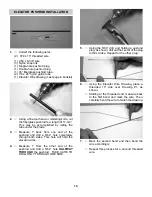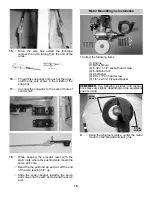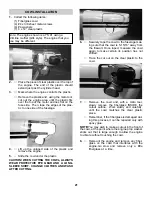
27
FLYING YOUR DECATHLON ARF
SETTINGS
Gentle
Aerobatic
AILERON:
3/8”
7/16”
ELEVATOR:
1-1/4”
1-5/8”
RUDDER:
3/4”
1-1/2”
When beginning to fly your
Decathlon
, we encour-
age you to start out with the gentle settings,
regardless of your flying ability. Then, after you
have become familiar with the aircraft, move to the
aerobatic settings.
NOTE:
Always use the furthest hole on all control
surfaces and adjust at the servo for proper throw.
Do not use the transmitter adjustment to set up the
control travels. The transmitter should be used only
for fine tuning.have become familiar with the aircraft,
move to the aerobatic settings.
NOTE:
Always use the furthest hole on all control
surfaces and adjust at the servo for proper throw.
Do not use the transmitter adjustment to set up the
control travels. The transmitter should be used only
for fine tuning.
SETTING CONTROL SURFACE TRAVELS
Fully-charged flight batteries
Radio transmitter
1 ½ volt starting battery & glo-plug clip
Fuel bulb or pump
Tools for tightening any parts that can vibrate
and loosen
Paper toweling for clean up
Extra props and an extra spinner
Prop wrench
Bottle of CA glue
FIELD KIT CHECKLIST
PRE-FLIGHT ACTIVITIES
Prior to going to the flying field, with radio batteries
fully charged, turn on both receiver (Rx) and trans
mitter (Tx) and actuate all controls many times until
you are satisfied with all functions.
Before beginning each day's flying, make a range
check of your equipment in accordance with the
manufacturer's instructions. In general, with trans-
mitter antenna collapsed to 6"-8", you should have
an at least 100 foot range on the ground. To check
this, turn on both the transmitter and the receiver
switches, set the model heading away from you,
and walk away while transmitting signals. Watch to
see that no signals are missed until you are at least
100 feet away. Only if the equipment works per-
fectly should any flights be attempted. Again, be
careful to not use your transmitter when anyone
else at the field is flying or testing on the same fre-
quency!
After the range check, stand behind the model and
make sure the control responses are correct.
Moving the control stick to the right should give right
aileron movement up. Moving the stick back or
down on the Tx should move the elevator up, and
vice versa.
Check also to see that your wheels operate proper-
ly Your throttle should open to permit full power
when the stick or tab is moved forward or up.
Finally, make sure that everything on your aircraft is
neatly and firmly in place-motor fastened down, ser-
vos snugged down, receiver and battery wrapped in
foam rubber, tank properly supported, etc. Prop and
spinner must be tight. The receiver antenna must
be extended, not coiled up inside the model.
Nothing should be loose, or unfinished, or
unchecked.
With everything ready, the engine should be started
and broken in for a least a tank or two at no more
than moderate speed. While the engine is running,
make sure the control surfaces do not jitter or move
until you command them and that the throttle also
responds properly to your command.
CGP Super Tote
TAKE-OFFS & LANDINGS
Though the
Decathlon
is not difficult to control dur-
ing take-off and landing, it is important to avoid over-
control. Make small smooth corrections until you
become familiar with the feel of your model. When
taking off, you will need to add a bit of right rudder.
Wait until there is plenty of airspeed and gently
rotate (about 1/8-1/4 up elevator), keeping the wing
level.
On landings, you will find that the
Decathlon
glides
Summary of Contents for decathlon arf
Page 29: ......



































